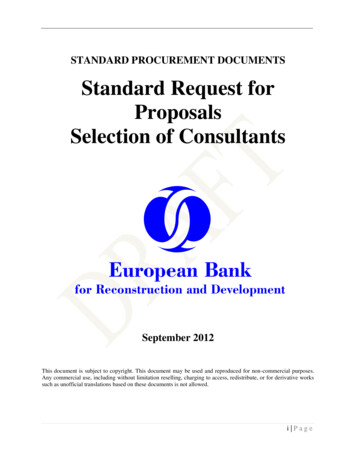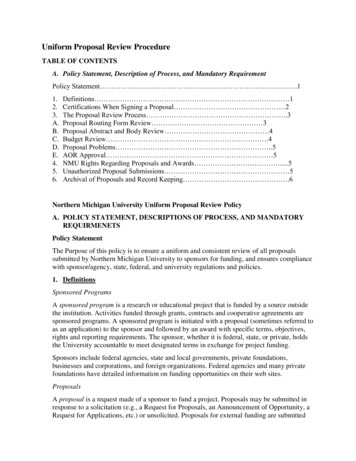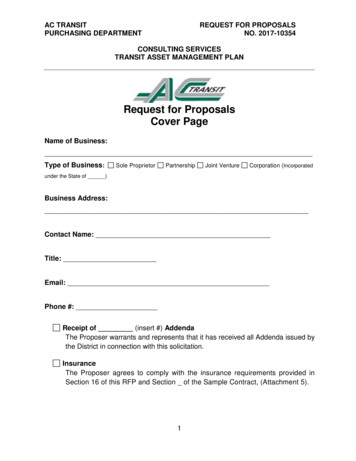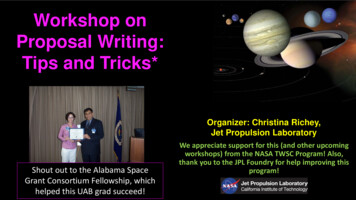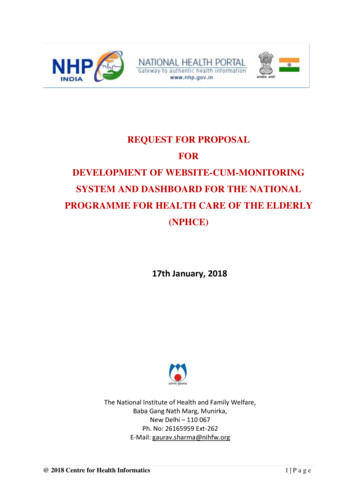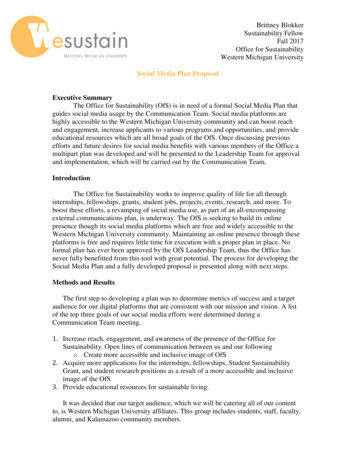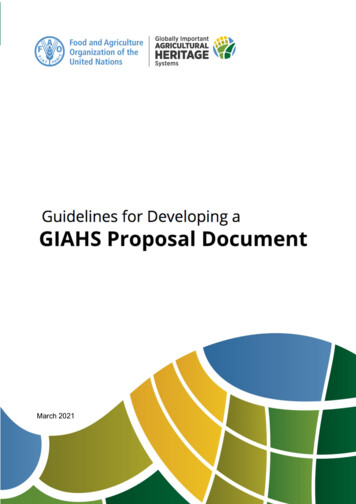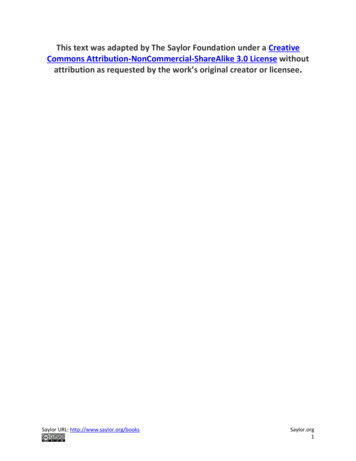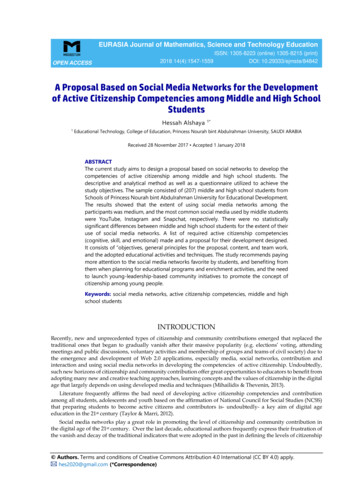
Transcription
EURASIA Journal of Mathematics, Science and Technology EducationOPEN ACCESS2018 14(4):1547-1559ISSN: 1305-8223 (online) 1305-8215 (print)DOI: 10.29333/ejmste/84842A Proposal Based on Social Media Networks for the Developmentof Active Citizenship Competencies among Middle and High SchoolStudentsHessah Alshaya11*Educational Technology, College of Education, Princess Nourah bint Abdulrahman University, SAUDI ARABIAReceived 28 November 2017 Accepted 1 January 2018ABSTRACTThe current study aims to design a proposal based on social networks to develop thecompetencies of active citizenship among middle and high school students. Thedescriptive and analytical method as well as a questionnaire utilized to achieve thestudy objectives. The sample consisted of (207) middle and high school students fromSchools of Princess Nourah bint Abdulrahman University for Educational Development.The results showed that the extent of using social media networks among theparticipants was medium, and the most common social media used by middle studentswere YouTube, Instagram and Snapchat, respectively. There were no statisticallysignificant differences between middle and high school students for the extent of theiruse of social media networks. A list of required active citizenship competencies(cognitive, skill, and emotional) made and a proposal for their development designed.It consists of “objectives, general principles for the proposal, content, and team work,and the adopted educational activities and techniques. The study recommends payingmore attention to the social media networks favorite by students, and benefiting fromthem when planning for educational programs and enrichment activities, and the needto launch young-leadership-based community initiatives to promote the concept ofcitizenship among young people.Keywords: social media networks, active citizenship competencies, middle and highschool studentsINTRODUCTIONRecently, new and unprecedented types of citizenship and community contributions emerged that replaced thetraditional ones that began to gradually vanish after their massive popularity (e.g. elections’ voting, attendingmeetings and public discussions, voluntary activities and membership of groups and teams of civil society) due tothe emergence and development of Web 2.0 applications, especially media, social networks, contribution andinteraction and using social media networks in developing the competencies of active citizenship. Undoubtedly,such new horizons of citizenship and community contribution offer great opportunities to educators to benefit fromadopting many new and creative teaching approaches, learning concepts and the values of citizenship in the digitalage that largely depends on using developed media and techniques (Mihailidis & Thevenin, 2013).Literature frequently affirms the bad need of developing active citizenship competencies and contributionamong all students, adolescents and youth based on the affirmation of National Council for Social Studies (NCSS)that preparing students to become active citizens and contributors is- undoubtedly- a key aim of digital ageeducation in the 21st century (Taylor & Marri, 2012).Social media networks play a great role in promoting the level of citizenship and community contribution inthe digital age of the 21st century. Over the last decade, educational authors frequently express their frustration ofthe vanish and decay of the traditional indicators that were adopted in the past in defining the levels of citizenship Authors. Terms and conditions of Creative Commons Attribution 4.0 International (CC BY 4.0) apply.hes2020@gmail.com (*Correspondence)
Alshaya / A Proposal Based on Social Media NetworksContribution of this paper to the literature Studies that tackled citizenship are rare. It is, to the author’s knowledge, the first study in the field.Its results could be used in planning and implementing the educational programs that develop citizenshipamong students.It enhances officials’ awareness of forming youth awareness of the importance of paying special attentionto the concept of citizenship by using modern techniques. contribution of the digital age citizens (e.g. attending meetings and public discussions, local elections’ voting,voluntary activities and membership of groups and teams of civil society), such as (Gordon, 2013; Putnam, 2000;Wattenberg, 2007). Despite the continuity of educators’ interest in the aforementioned indicators as key componentsof citizenship, they increasingly become far from the present situation of citizenship contribution activities in ourworld of the wide spread of using social media networks in bridging communication, interaction and contributionamong the different communities (Mihailidis & Thevenin, 2013).Social media networks are means of discussing the various perspectives and making hear the different sounds.They facilitate discussing immediate issues. Many pieces of the literature review confirm the importance of thecontribution of education- especially teachers- and community effectively and positively affect efforts made toprepare students and give them knowledge, values and practices of citizenship in our multi-cultural age of the 21stcentury to equip them with the required competencies (Maguth, 2012).However, it is noticed that Arab studies are only focusing on the intellectual frame and concepts and that foreignones focus on real and effective mechanisms to be published and developed in the culture of citizenship andincreasing focus on their conditions, duties and rights that should be defined by law and the role of education inconsolidation via scientific programs. Hence, the current study aims to design a proposal based on social medianetworks for the education of students on citizenship.STATEMENT OF THE PROBLEMThe problem of the current study is defined in the need to a proposal based on social media networks for thedevelopment of active citizenship competencies among middle and high school students. It can be formed in askingthe following major question:What is the proposal based on social media networks for the development of active citizenship competenciesamong middle and high school students?It is, further, divided into the following minor questions: To what extent do middle and high school students use social media networks? What social medium is used most by middle school students? What social medium is used most by high school students? Do middle and high school students differ in using social media networks? What are the competencies of active citizenship of middle and high school students? What is the proposal based on social media networks for the development of active citizenship competenciesamong middle and high school students?OBJECTIVESThe current study aims at: Shedding light on the importance of students’ education of citizenship and identifying current attitudes incitizenship education. The importance of using social media networks for the development of active citizenship competenciesamong students. Defining the key competencies of active citizenship. Making a proposal for the development of active citizenship values among middle and high school students. Trying to fit up with rapid and consecutive changes in the current trends of citizenship education.1548
EURASIA J Math Sci and Tech EdSIGNIFICANCEIt is significant because:1- Citizenship education is a positive contribution in the field of education, culture and science.2- Studying the factors that affect citizenship issues makes us aware of the past, corrects the present andpredicts the future.3- Interest in citizenship and its education enhances the progress of the community, in general, and that ofcitizenship, in particular.4- Studies that tackled citizenship are rare. It is, to the author’s knowledge, the first study in the field.5- Its results could be used in planning and implementing the educational programs that develop citizenshipamong students.6- It enhances officials’ awareness of forming youth awareness of the importance of paying special attentionto the concept of citizenship by using modern techniques.LIMITATIONSThe present study was conducted in 2016; it is limited to the Schools of Princess Nourah bint AbdulrahmanUniversity for Educational Development. It dealt with citizenship.STUDY TERMSCitizenshipLinguistically, citizenship, according to (Ibn Manzour, 1994), is attributed to nation where a person lives, itsplural is nations.Active CitizenshipBobek, Zaff, Li, and Lerner (2009) defined active citizenship as, primarily, referring to a certain group ofindividuals who have a shared commitment to actively contribute to all community activities and events to makethem stronger, more effective and safer than the past”.Zaff, Boyd, Li, Lerner, and Lerner (2010) defined active citizens and contributors as a group of people with astrong sense of assuming performing their assigned national duties. They are overwhelmed with the feelings ofsocial connection and integration and trust in their abilities to make the aspired change”. The authors procedurallyadopted the definition of Zaff et al. (2010).Active Citizenship CompetenciesThey are procedurally defined as “the set of acquired behaviors of knowledge, skills and attitudes that shouldbe developed to be an active citizen”.Social Media NetworksThey refer to a group of developed Internet-based applications that depend on technological bases of Web 2.0tools. They provide users with different and unprecedented opportunities to design, produce and contribute to thedissemination and using the content and applications of the web in a way that allows preparing and exchangingthe designed content of the web by the user (Vanwynsberghe, Boudry, & Verdegem, 2011).CONCEPTUAL FRAMEWORKAccording to Rubin (2007), active citizenship is the active and effective contribution of citizens in a group offormal civil activities (e.g. activities of electoral campaigns) and other informal ones (e.g. discussing current eventsand political issues with friends and family members and contribution to voluntary activities in the localcommunity).Bogard and Sherrod, (2008) reports that the active citizen is that person who understands duties and obligations,assumes responsibilities to improve and develop life situations and tries to build more effective communitiesbesides successfully facing different community problems. In addition, s/he has accurate understanding and anurgent need to use the opinions, perspectives and contributions of all members. Rubin (2011) illustrates that1549
Alshaya / A Proposal Based on Social Media Networkseducational authors should focus on shedding more light on the motives of students, adolescents, and youth ofactive national and societal contribution by going deeper into the analysis of daily life experiences- whether insideor outside schools.THE CONTEMPORARY EDUCATIONAL PERSPECTIVE OF ACTIVECITIZENSHIP IN THE DIGITAL AGECurrently, massive and large-scale spread of the developed techniques allowed the emergence of the variouspatterns and new forms of citizenship and its development. According to Castells (2012), there was lately a largescale development and progress of “Networked Social Movements” that basically depend on using social meansand media that are available on the Internet. This contributed to re-frame and frame our contemporary educationalperspective of the national and social contribution that are not limited to revolutions and large-scale political andnational uprisings only, but cover contributions and daily interactions of the current man with his different personaland social issues. It is noted that efforts made by educators to reconsider the concept of national contribution shouldfocus on youth contribution in the different social activities to surpass the traditionally limited scale of the oldconcept of citizenship (Allan, 2012).In addition, educational tools and effective teaching strategies- whether formal or informal- can help createpreparing future citizens for a different life of political, social and cultural systems more collaboratively andcomprehensively for all people (Bachen et al., 2008; Bennett, Wells, & Rank, 2009; Thevenin, 2012). It is affirmedthat youth of our digital age currently adopt applying the patterns and forms of active citizenship by using differentstrategies, such as: Flash mobbing, Citizen reporter blogging, Online petitions, Online charities . etc. (Loader, 2007, 116).Bennett (2008) introduces a 2D categorization of the contemporary educational perspective of citizenship in thedigital age. It consisted of two main types of citizens:1- Actualizing citizen who often tends to follow networking thinking styles and using developed techniquesin reflection on national ideas, issues and problems personally and2- Dutiful citizen who sticks to adhering to the old and traditional ideas of national and social contribution.Disagreement of the traditional and contemporary perspective of citizenship is a direct result of the significanteffects of digital techniques that unprecedentedly contribute to change the paradigms, concepts and behaviors ofcitizenship. “This allowed us to crystallize the features of understanding the best reasons that motivate educationalauthors to disagree on understanding the philosophy of national and social contribution and whether to adhere toold thoughts or moving to draw an unclear image of the future” (Bennett & Wells, 2009, 7).Gordon (2013) suggests that liberation from the traditional perspective of citizenship and shifting to achieve thegreatest benefit of using the developed capabilities of social media and networks of promoting the levels ofcontribution, learning and social bridges with others. It is clearly noted that these suggestions on “the nationalweb” totally focus on trying to achieve a final shared objective of building and polishing core competencies requiredto be available for future generations to be able to accomplish the greatest benefit of adopting the techniques andsocial media networks to develop citizenship.Consequently, the features of a new perspective of active citizenship and participation should be crystallized inthe digital age, rather than merely seeing users and social media networks as negative consumers of informationthe same as TV audience, cinema visitors, radio listeners or newspapers and journals’ readers.The educational importance of active citizenship is based on the basis of youth active participation to promotethe levels of individual development with supporting the feeling of family welfare and increasing the levels of thecivil texture’s cohesion and coherence of the different communities. When young men dynamically participate inpromoting the welfare of their communities and countries, this is positively reflected in consolidating their selfdevelopment and establishing the strong basis of creating the active civil society (Phelps et al., 2009). In the samecontext, (Lerner et al., 2005; Lerner, Phelps, Forman, & Bowers, 2009) and (Sherrod, 2007) illustrate the strongconnection between mastering the competencies of active citizenship and cooperation and activating youth abilityof national participation that currently represent a key principal of activating positive development of theirpersonality and developing their ability on acquiring the required values on all levelsAccording to Jenkins et al. (2009, b), these interactive competencies of active citizenship and cooperation arebased on developing interactive skills that “enable citizens of contribution, interaction, indexing, commenting,categorizing, publishing and discussing the content of social media and networks’ messages using new and1550
EURASIA J Math Sci and Tech Edeffective methods and styles”. Putnam (2000) illustrates that these participatory competencies firmly establish socialrelations with others and active citizens contributing to interactive environments that enable them of discoveringtheir abilities to build social relations and broadening their connections to cover a large group of peers concernedwith interacting with them personally and socially.As a result, they are able to benefit from adopting the developed techniques of social media and networks inexpressing themselves and establishing active connections with other peers to activate their abilities on buildingknowledge and publishing and discussing the required information.Those citizens are able to reflect on the content of the messages of social media and networks to individuallyand socially express themselves. Consequently, they can move to higher levels of participation in the larger andwider national discussions with other members of the society.PROCEDURESI.II. Methodology of the Study: The current study used the descriptive and analytical method that studies thephenomenon as it is by collecting, categorizing and organizing data and expressing them to get toconclusions or generalizations to develop this situation. Population: The population of the study includes all middle and high school students in Saudi Arabia. Sampling: Middle and high school students of Princess Nourah bint Abdulrahman University forEducational Development. Tool of the Study: Because the study aimed to identify a proposal based on social media networks toconsolidate citizenship among youth in the Kingdom of Saudi Arabia, a questionnaire should be made, asfollows:Reviewing literature related to the sections and objectives of the study.Reviewing data from the world-wide web and social media networks to identify the most significant onesused by youth or students in the middle or high school.In its first draft, the questionnaire consisted of (8) items.I. Validity: A. Validity of Internal Consistency:Pearson Correlation Coefficients to measure the relation of items to the total mark.Table 1. Items’ correlation coefficients to the total mark (Pilot sample: n 30)No.Correlation 8* Significant at the level of 0.05 **significant at the level of 0.01Correlation coefficient0.7263**0.5170**0.5679**0.8280**II. Reliability:Table 2. Cronbach’s alpha coefficients of the tool (Pilot sample: n 30)VariableNo. of items:all items of the tool8Cronbach’s alpha coefficient0.711551
Alshaya / A Proposal Based on Social Media NetworksIII. Description of the Sample: Preliminary Data:Table 3. Distribution of the sample per educational stageStageMiddleHighTotalTable 4. Distribution of the sample per 923.2100.0To facilitate results interpretation, the author uses the following style to define the level of answering the itemsas follows: (Strongly agree 3, Moderately agree 2, disagree 1). Then, they were categorized into three equallevels by this equation:Length of the category (greatest value- least value) number of alternatives (3-1) 3 0.67To get to the following categorization:Table 5. Distribution of the categories of the scale used in the tool of the studyDescription:Strongly agreeModerately agreeDisagreeRange of means2.34 – 3.00.1.68 – 2.33.1.00 – 1.67.IV. Answering the Questions1-The first question: To what extent do the students from Schools of Princess Nourah bint Abdulrahman University forEducational Development use social media networks?Table 6. Frequencies, percentages and arithmetic means in a descending order of the participants’ answers on using social o.Social media 37Using YouTube2.540.611%60.433.36.3T12552303Using Instagram2.460.742%60.425.114.5T13134426Using Snapchat2.430.813%63.316.420.3T28771021Using Twitter1.640.714%13.537.249.3T24621212Using Wiki1.530.705%11.630.058.5T21531335Using Tumblr1.460.676%10.125.664.3T26441378Using Path1.460.716%12.621.366.2T7321684Using Facebook1.220.498%3.415.581.2General means of using social media networks1.84* Arithmetic mean out of 3Table 6 shows that social media networks’ use by the students from the schools of Princess Nourah bintAbdulrahman University for Educational Development is medium. Items achieved an arithmetic mean of 1.48 thatmatches a (medium response). This agrees with (Jenkins et al., 2009; Mihailidis, 2013; Thevenin, 2013;1552
EURASIA J Math Sci and Tech EdVanwynsberghe et al., 2011). Therefore, the author suggests using social media networks in the programs andtraining workshops for students on developing competencies and deepening nationhood and using them ininteraction and discussing problems they face.2-What social medium is used most by middle school students?Table 7. Frequencies, percentages and arithmetic means in a descending order for the answers of a sample of middle schoolstudents on using social media networksStrongly ModeratelyArithmetic StandardNo. Social media 7 Using YouTube2.610.611%67.226.36.6No9527153 Using Instagram2.580.682%69.319.710.9No9515276 Using Snapchat2.500.813%69.310.919.7No1643781 Using Twitter1.550.704%11.731.456.9No2027908 Using Path1.490.745%14.619.765.7No1035925 Using Tumblr1.400.626%7.325.567.2No1230952 Using Wiki1.390.657%8.821.969.3No3221124 Using Facebook1.200.468%2.216.181.8General means of using social media networks1.84* Arithmetic mean out of 3Results showed that the most common social media used by high school students were YouTube, Snapchat andInstagram, respectively, with an arithmetic mean of 2.43-2.54. This means that they use them to a high degree. Thatis, their responses are approximate. This result is consistent with Abdulshafy (2011) that the most common socialmedium among the participants is YouTube. However, it disagrees with (Ishtaiwa & Dukmak, 2013) reporting thatthe majority of the participants believe that blogs and wiki are strong tools to consolidate learning. They also believethat blogs are more effective in learning than wiki.3-What social medium is used most by high school students?Table 8. Frequencies, percentages and arithmetic means in a descending order for the answers of a sample of high schoolstudents on using social media networksStrongly ModeratelyArithmetic StandardNo.Social media 7Using YouTube2.410.601%47.147.15.7No3619156Using Snapchat2.300.802%51.427.121.4No3025153Using Instagram2.210.783%42.935.721.4No1234241Using Twitter1.830.704%17.148.634.3No1232262Using Wiki1.800.715%17.145.737.1No1118415Using Tumblr1.570.756%15.725.758.6No617478Using Path1.410.657%8.624.367.1No410564Using Facebook1.260.568%5.714.380.0General means of using social media networks1.85* Arithmetic mean out of 31553
Alshaya / A Proposal Based on Social Media NetworksTable 8 illustrates that the most common social media used by high school students were YouTube, Snapchatand Instagram, respectively, with an arithmetic mean of 2.21-2.41. This means that they use them to a high degree.That is, their responses are approximate. The result is consistent with (Abdulshafy, 2011) that the most commonsocial medium among the participants is YouTube. However, it is inconsistent with (Ishtaiwa & Dukmak, 2013)reporting that wiki is strong tools to consolidate learning.4-The third question: Do middle and high school students differ in using social media networks?Table 9. T-test of the significance of differences in the responses of the participants on using social media networks pereducational stageArithmeticStandardSignificanceEducational StageNumber“T” valuemeandeviationlevelMiddle school1371.840.39Insignificant0.180.861High school701.850.33Table 9 illustrates that (T) value is insignificant; suggesting that there are no statistically significant differencesamong the responses of the participants on using social media networks that could be attributed to the educationalstage. This is attributed to the approximation of the age group of middle and high school students.To answer the fifth question:5-What are the required key competencies for active citizenship?Literature (e.g. Abs & Veldhuis, 2006; De Weerd, Gemmeke, Rigter, & Van Rij, 2005; Rychen & Salganik, 2003;Westheimer & Kahne, 2004) was reviewed. Then, they were defined, as follows:1- Knowledge Competencies that cover using citizens of a new theoretical knowledge, as follows: Key components that form the political and judicial system on local, regional and national levels, e.g.knowing the basic rights and duties of citizenship. Historical knowledge of the past, e.g. knowing major events and prominent historical figures thatchanged the process of the political system. Major events and prominent historical figures that currently contributes to changing the process ofhistory and the current political system. The role of mass media in personal and social life. Relations and social rights of citizens in the society. Cultural dating and heritage of the state and its effect on the domination of certain cultural standardsand values. Different cultures that interact whether on the levels of school, local community or the country at all. Major events and characters affecting changing the process of national and international dating. Tasks and activities of voluntary groups in the society.2- Attitude Competencies that cover forming positive national attitudes by the citizens, e.g.1554 Supporting the political community. Trying to accomplish justice, equality and equal opportunities, so that all citizens receive fair and equaltreatment. Forming a positive image of the self, trust of the personal strengths and weaknesses and setting andimplementing real plans. Respecting differences with others as a result of the differences of gender/sex, language and religiousbeliefs. Facing negative phenomena of fanaticism, discrimination and marginalization. Forming democratic attitudes, assuming responsibility, trust and interface with democratic principlesand institutions. Feeling of citizenship. Respect and tolerance for others, accepting and openness to change, the ability to adaption and findingsolutions to problems. Taking initiatives and persistence in facing the different challenges. Respecting human rights (e.g. freedom, equality and diversity of human beings). Respecting the freedom and dignity of all people.
EURASIA J Math Sci and Tech Ed Realizing the importance of active and effective participation in politics and society. Desire in supporting the poor and marginalized rather than keeping the surrounding environment.3- Skill Competences that cover citizens having scientific or applied skills required to perform: Contribution to social discussions, awareness of contemporary issues and problems, being able toevaluate decisions and making and defending certain intellectual situations. Solving conflicts in peaceful ways, being able to make judgments and making decisions. Understanding, interpreting and evaluating media messages received by the different mass media froma perspective that focuses on interests and related systems. Having linguistic competencies, especially reading and writing. Being able to deal with the content of information and communication technology (ICT) from a criticalperspective. Having the skills of looking for, storing, retrieving, organizing and logically analyzing the requiredinformation. Mastering using social media and networks. Having communication skills. Using different technological means interactively and actively that the citizen is not just a consumer buta producer of the informational content offered by the various means. Contribution to the activities of associations, organizations and volunteer institutions of the civilcommunity. Understanding the rules and criteria of participation and contribution with others creatively. Establishing cooperation and interaction with other members. Having the ability to understand, accept and reflect on others perspective and persuading them of theright opinion using arguments. Being able to handle issues and challenges of cultural diversity in the community.Answering the sixth question:6-What is the proposal based on social media networks for the development of active citizenship competencies amongmiddle and high school students?After defining the core competencies required to use social media networks and reviewing literature (e.g.,Deakin, Coates, Taylor, & Ritchie, 2004; Kerr et al., 2007; Maslowski, Breit, Eckensberger, & Scheeren, 2009), theauthor making the following proposal to develop active citizenship in the light of core competencies to be reviewedby a group of experienced and specialized reviewers in education, psychology and learning techniques to giveopinions on the following:A. Action objectives relation to the general one.B. Appropriateness of the content and activities to accomplish the objectives.C. Appropriateness of the material and its style of display.Reviewers made some modifications, as follows: Editing some action objectives, Adding some activities and linguistic and terminological modifications. Then, the proposal is ready in itsfinal form, made of the following items: objectives, general principles, content, teamwork and activities andeducational techniques used. The following section is a display of each item.General Objective: Development of key competencies of active citizenship through social media networksamong middle and high school studentsAction objectives: Consolidating unified cultural identity and citizenship. Using social media networks for the development of citizenship among students. Development of key competencies of active citizenship through social media networks among middle andhigh school students Forming discussion groups of the danger of fanaticism and extremism. Handling the cases of students to handle the danger of fanaticism and extremism via social media networks.Defining basic principles of the proposal: Implementing the proposal is based on many principles, as follows: Using soci
the emergence and development of Web 2.0 applications, especially media, social networks, contribution and interaction and using social media networks in developing the competencies of active citizenship. Undoubtedly, such new horizons of citizenship and community contribution offer great opportunities to educators to benefit from
